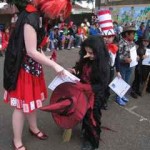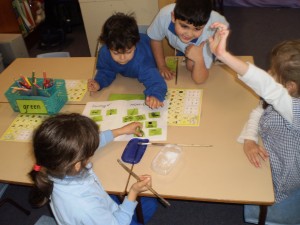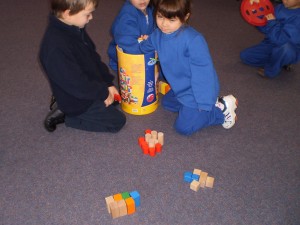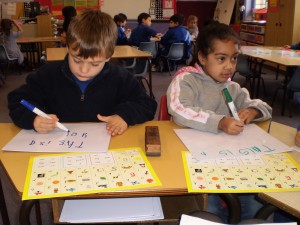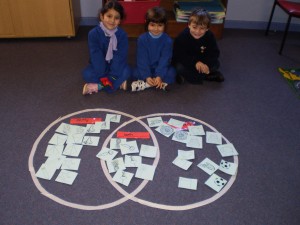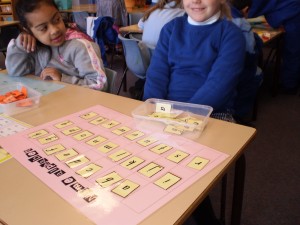Stage 1 made funny face biscuits by following a procedure in literacy groups with Mrs Filacouridis. We used icing, biscuits, lollies and sprinkles! They were delicious.
Category Archives: Literacy
Reading with S1Picasso
Looking After Pets
In our reading groups this week, we have been reading a book called “Pets Need People”. It talks about things you need to know when you have a pet. S1 Baker has guinea pigs as their class pets. We learnt about guinea pigs and then we took photos with them. Here are some things we found out about guinea pigs.
What do Guinea Pigs look like?
Guinea pigs have black eyes, ears and no tail. They have white, brown, yellow or black fur. Guinea pigs have short legs with clawed feet. They have 4 toes at the front and 3 toes at the back. Guinea pigs also have sensory whiskers.
Where do Guinea Pigs live?
Guinea pigs need a hutch for shelter. They do not like cold, wet windy places. Guinea pigs like to be let out of their cages and petted. They need to have their cages cleaned regularly.
What do Guinea Pigs Eat?
Guinea pigs like to eat apples, grass and other plant material.
Interesting Facts?
Guinea pigs are popular pets. They live for 6 to 8 years, they grow to 28 cm and weigh 0.9kg. They are burrowing animals and they squeal when they are excited.
This is Gus. He visited our class from S1Baker. He felt so soft and made a noise when we patted him.
Great Schools ‘Show Off’!
This year Belmore South Public School has entered the ‘Great Schools Show Off’ competition. This exciting new project engages students in telling their community, and the wider world, about the many positive and exciting aspects of their school through the use of digital media.
Throughout Term 2 our new film club ‘Short Cuts’ will be working with Miss Pleasance to create a 3 minute film that will promote our great school. Creating this film will involve many different aspects of development including storyboarding, creating scenes and shots, directing, producing, filming, editing and acting (just to name a few!).
Panasonic will be providing the following prizes for regional and state winners:
Regional Winners will each receive a: Digital still tough camera – valued at $499
State winners will each receive a: High Definition Camcorder – valued at $1,499 and 42″ High Definition Plasma TV – valued at $1,099
Stay tuned for regular updates, photos and eventually our Great Film!
Wakakirri News
This year Belmore South Public School will be participating in the National Wakakirri festival. This festival is a performing and visual arts festival created specifically for primary schools to teach students about themselves and others through the creating and sharing of stories. Wakakirri challenges students to create a story, make a positive impact and share it with Australia. Interested students were asked to go through an audition process which required them to dance, act and demonstrate their skills in team building. Fifty students from Years 3-6 were successful and rehearsals have now commenced.
In accordance with our National Partnerships objective our story focuses on the role of reading; from the traditional storytelling of the many cultures within our school through to the use of modern technology. The main character of our story, which will be played by Puni, is a ‘cool cat’ who has difficulty reading. Through the use of technology he is exposed to the storytelling traditions of Arabic, Greek, Pacific Islander, African and Asian cultures which inspires him to read. The item will end with a celebration of reading through dance.
This is an amazing opportunity for our school community and students to display our many talents at the Sydney Entertainment Centre.
Stay tuned for regular updates including performance date and time, progress reports and snapshots of our creative process. 
The Lorax Plays Assembly
In today’s Assembly S3 Baz entertained us with their rendition of Dr Seuss’s The Lorax.
The Lorax was the protector of the Environment which was destroyed. As the environment deteriorated all who lived in it including the Lorax disappeared. But was the Lorax gone forever? Was there still hope for the future?
The performance was fantastic: the performers excellent, costumes colourful and the scenery sensational.
Congratulations to all merit award winners and to S1 Base and S3 Fred who won the Assembly Awards.
Queen of Hearts visits Book Week Celebrations
Here she is presenting class Best Costume Winners their certificates.
Book Week Parade next Friday
What: Belmore South is having a BOOK PARADE! Dress up as a character from your favourite book.
Bring the book on the day to share with your class.
All Parents are invited to attend.
When: Friday 27th August 2010 (Week 6) from 11.30-12.50
Where: Belmore South Public School, Area 2 under the COLA near the New Hall
Why: To celebrate BOOK WEEK, the theme is: Across the Story Bridge
BSPS Blog Comments
BSPS BLOG COMMENTS
In order to promote leaving comments on posts on the school blog, each comment left will contribute towards class of the year award.
Comments must be meaningful and relevant to the post to be counted
- Examples include:
- commenting on what you have learnt about from the post
- what you liked about the post and why
- What you have been doing on the same topic or what further information you could add to the post
- posing further questions if you would like to know more about the post
Comments can be jointly constructed as a class or part of a literacy group. Students can leave individual replies but they must be checked by the teacher first.
Please use first name only and leave class name so we know which class posted them.
Thanks Technology committee
Watch out for the dinosaurs!
Stage 2 reading groups have been reading and learning about dinosaurs. Students have been reading information texts, and have been learning to locate information in texts by using the contents page, captions, diagrams and headings.
Students selected and researched one dinosaur of interest. They wrote short information reports and labelled diagrams about them.
Have a read of some great examples:
Triceratops (By Jimmy)
Triceratops was a dinosaur. Its name means three-horned face.
Triceratops had a large head with three horns on it. Around its neck it had a thick, bony plate.
Triceratops was a plant-eating dinosaur. It lived in forests and grasslands.
Brachiosaurus (By Victoria)
Brachiosaurus was a dinosaur. It means arm lizard.
Brachiosaurus had a long neck and a thick tail.
Brachiosaurus ate leaves in the tops of trees. Brachiosaurus lived in forests near lakes. This dinosaur liked standing in water.
Do you have any questions about dinosaurs? Perhaps we can answer them for you by finding the information in our dinosaur books.
A Wonderful Week of the Wiggles at Work
Spelling sight words
Interacting with ipods
Matching sounds
Identifying numbers with maths games and number chart puzzles
Problem solving and team work
Sorting
Story Writing
Classifying
Ordering
…. All for the fun to be had in Golden Time.





















